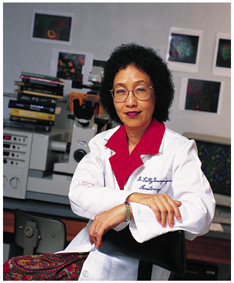What Drives Basic Research?
![]() y colleagues at the Diabetes Research Institute (DRI)
and the UM/Sylvester Comprehensive Cancer Center place a great
deal of importance on translational medicine and moving research
findings more quickly into the clinical setting. As a basic scientist,
I support their vision. I will even go so far as to state that
I would not apply for, or enter into projects that don't show
scientific advancement with clinical relevance.
y colleagues at the Diabetes Research Institute (DRI)
and the UM/Sylvester Comprehensive Cancer Center place a great
deal of importance on translational medicine and moving research
findings more quickly into the clinical setting. As a basic scientist,
I support their vision. I will even go so far as to state that
I would not apply for, or enter into projects that don't show
scientific advancement with clinical relevance.
There are misconceptions today that clinical collaboration
somehow means science is compromised. I beg to differ. Untargeted
research has always had a place in medical research. Without
it, smallpox, polio, and pneumonia still would be killers and
cripplers. But what moved Jonas Salk's polio vaccine out of the
lab and into application was his clinical collaboration, which
today remains one of the largest trials ever conducted. Many
of us recall the long lines of people receiving the vaccination
that led to polio's eradication. This is what biomedical research
is all about. The way I see it, if I'm a basic scientist at a
medical school, why not ask the clinical questions?
 To attack diseases such as
cancer, heart disease, and diabetes, we need a broader base of
knowledge that provides much faster results in moving our findings
from labs to clinical trials. Collaboration between scientists
and clinicians can shorten the time to develop effective treatments
for the patient. The bottom line: More resources and support--whether
financial, human, or scientific-facilitate faster exchange and
progress.
To attack diseases such as
cancer, heart disease, and diabetes, we need a broader base of
knowledge that provides much faster results in moving our findings
from labs to clinical trials. Collaboration between scientists
and clinicians can shorten the time to develop effective treatments
for the patient. The bottom line: More resources and support--whether
financial, human, or scientific-facilitate faster exchange and
progress.
 Speaking of the bottom line,
another reason collaboration has become so vital is that the
National Institutes of Health, the primary U.S. funding source
for basic science research, has begun requiring collaboration
in its proposals. Both government and private funding sources
favor projects for which clinical utility can be demonstrated;
NIH focuses more on proposals that include disease-relevance
information.
Speaking of the bottom line,
another reason collaboration has become so vital is that the
National Institutes of Health, the primary U.S. funding source
for basic science research, has begun requiring collaboration
in its proposals. Both government and private funding sources
favor projects for which clinical utility can be demonstrated;
NIH focuses more on proposals that include disease-relevance
information.
Public opinion has influenced the direction of clinically relevant
research during the last decade. Taxpayers who fund NIH research,
as well as public interest groups such as breast cancer survivor
organizations, are demanding greater accountability and faster
results.
I am often referred to as a cancer cell biologist; however, only
five or six years ago, my laboratory was still pursuing relatively
untargeted basic science research. In recent years, the NIH and
Army Breast Cancer Medical Research Program directive motivated
scientists and clinicians to collaborate. In fact, some of our
current work with clinical investigators at UM/Sylvester is a
result of these initiatives. My clinical colleagues knew that
as a cell biologist, I had an in-depth understanding of cellular
regulation. When certain cells behave inappropriately during
cancer progression, it is vital that we identify and characterize
the abnormal cellular segregation, movement, growth, and signaling
that "turns on" cancer cells, making them so deadly
and resistant to treatment.
And that was just the beginning. Now, I also collaborate with
colleagues at the DRI, Parkinson Foundation, and others on the
medical campus. Our combined creativity plays a major role in
establishing hypotheses for our projects.
It is important for basic scientists to forecast their involvement
in future clinical advances and requirements. We need to be innovative
and recognize that high-risk research projects yield high return.
We can no longer do the same old closed-door laboratory science
if we expect to contribute to the advancement of medical science.